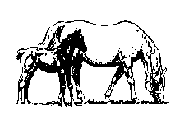Starting foals' worming and vaccinations...
HEALTH MANAGEMENT OF THE FOAL
It would not be fair or healthy for the foal to allow it to reach weaning age without the preventative care we give the adults! Today we will discuss the vaccination and worming programs for the foal pre-weaning.
The foal is the most susceptible to disease and parasites of all the age groups of horses. With the first milk they receive passive immunity in the form of colostrum. Colostrum contains antibodies to the organisms mother was previously exposed to either by vaccination or contact. This immunity is passive and goes to work during those critical days immediately after birth when the foal is the most vulnerable. This immunity decreases with time and by six weeks is starting to taper off rapidly.
Not to leave her babies defenseless, Mother Nature provides the foal with an immune system of it own. This system becomes active when the foal reaches six to eight weeks of age. The foalís immune system will start producing antibodies to the organisms it comes into contact with. There is a period of two to four weeks when the foal is especially vulnerable. This is the period when the passive immunity is at a low and the foalís own system is just starting. Unless exposed to a high concentration of organisms such as at sale, a healthy foal will cruise through this time with few apparent problems.
The respiratory vaccinations (influenza, rhinopneumonitis, strangles) need to be boostered every six months. The rabies virus only requires one initial vaccination with a booster in a year. Tetanus and sleeping sickness are boostered each year.
The best approach to deworming the foal is with use of the daily dewormer, which is added to the feed. This can be started as soon as the foal has a feeder of its own and is cleaning up a small amount of feed. The dewormer is in an alfalfa crumble and readily acceptable by the baby.
It is never to early to contact your farrier. Early trimming will help straighten those crooked legs. Almost all foals will have at least one foot that will turn out. Early trimming will help correct these before the major bones of the legs start twisting.
As weaning approaches, you can start reducing the grain intake of the mare. Unless she is very thin, starting two weeks prior to the anticipated weaning date reduce the grain to a token amount. This will reduce the mareís milk output. If the mare is producing less milk, her udder will not swell so tight when the foal is away; and drying off will be greatly simplified. The reduction of milk output will leave the foal a little hungry and encourage it to search out the grain. At weaning, it can turn to the grain to relieve the hunger pangs left by motherís absence.
CLICK BELOW TO DISPLAY A PRINTER-FRIENDLY COPY OF THIS ARTICLE
Select "Open this file from its current location," if you just want to print it out,
it will open in a simple word processing application, select the print button.
(unless you want to save this article in your computer's memory)

 HEALTH__MANAGEMENT_OF_THE_FOAL.rtf
HEALTH__MANAGEMENT_OF_THE_FOAL.rtf